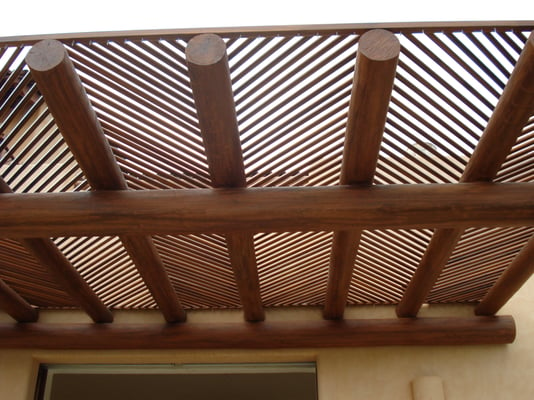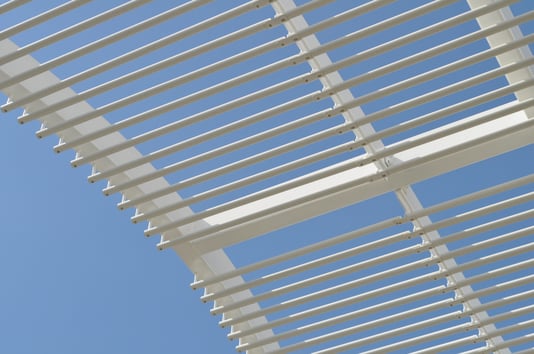In the realm of architectural design, few elements exhibit the versatility of trellises. From...
Trellis Architecture with FRP for Shade and Style
In the realm of architectural design, few elements exhibit the versatility of trellises. From simple to ornate, architectural trellises can be as practical as they are beautiful, particularly when used to create a shaded area, as in the case of a pergola. Read on to explore how trellises excel in their role as shade providers by protecting inside areas from the sun’s heat and by transforming outdoor spaces into cool and inviting sanctuaries. We will also look at how fiberglass reinforced plastic (FRP) is revolutionizing trellis applications.
|
PHOTO 1: Fiberglass reinforced plastic (FRP) trellis application at UT-Dallas |
What is Trellis Architecture and What are the Benefits?
Trellises are pierced wall designs featuring a lattice-like framework made from various materials, but as we’ll discuss, a trellis can also be a “roof” or covering. Materials may include sturdy wood, resilient metal, flexible bamboo, or modern materials like fiberglass reinforced plastic (FRP). Trellises serve as an architectural canvas that blends form and function.
Their design versatility makes them a practical addition to a building or expands functionality in an outdoor space. Here are a few benefits:
- Shade: They can be used to create shade for seating areas, outdoor rooms, or walkways. Trellises don’t completely obscure the view, so it’s like getting the best of both worlds—beautiful vistas of nature and the sky plus some protective shade.
- Privacy: They can offer a degree of privacy by partially obstructing views from neighboring buildings or public spaces, creating a more intimate environment.
- Aesthetic Enhancement: Architects and designers often turn to trellises as decorative elements to enhance the visual appeal of a building's exterior or to make an outdoor space more versatile. Available in various patterns, designs, and materials—not to mention a variety of color options—there are many opportunities to incorporate artistic and creative trellis elements into a building's visual impact. In an outdoor space, a traditional use of an architectural trellis can be found in a pergola or arbor for supporting plants.
 PHOTO 2: Fiberglass reinforced plastic (FRP) trellis application. PHOTO 2: Fiberglass reinforced plastic (FRP) trellis application. |
Key Decisions to Make about a Trellis Architecture Project
Whether residential or commercial, every construction project has key architectural considerations. Adding a trellis element or pergola is no different. Briefly, these five primary factors play a part:
- Material Choices: Trellises can be constructed using a variety of materials, including wood, metal, bamboo, and fiberglass reinforced plastic (FRP). Beyond the costs associated with each material (including the expense of installation), consider the intended style, durability, and maintenance requirements. When considering total cost, both initially and in the long term, FRP grating often makes a smart choice for trelliswork. Compared to other materials, it is lightweight and easy to install. Unlike wood or metal building materials, FRP is resistant to corrosion, rust, mildew, and staining allowing it to have a much longer lifespan than traditional products. UV resistant coatings can add even more longevity.
- Integration with Architecture: Through careful planning and a keen eye for detail, these versatile structures can seamlessly become an integral part of the overall architectural composition. Trellises can be strategically utilized on a variety of architectural features such as balconies and terraces to almost any exterior surface. They serve as dynamic elements that enhance the building's overall aesthetic coherence, reinforcing the chosen design language. This union of form and function ensures that trellises not only contribute to the building's visual appeal but also become essential architectural elements that elevate and harmonize the structure's overall presence within its given surroundings
- Functionality and Practicality: Apart from visual appeal, trellises can also have a practical function such as reducing solar heat gain on building surfaces, enhancing natural ventilation by allowing air to flow through the lattice, and contributing to rainwater management. FRP grating, in particular, is thermally non-conductive, making it a superior alternative to metal materials.
- Outdoor Functionality: Again, when used as shade in the case of a pergola, for example, architectural trellises add visual appeal and utility in outdoor spaces.
- Customization: A standout feature of trellis architecture is its customizability. Architects can enjoy the creative freedom to fine-tune trellises according to a building's specific requirements, from optimizing design and adjusting size to precisely determining placement—all to maximize the aesthetic, functional, and climate control benefits. In that sense, FRP grating can play a pivotal role, offering a broad range of colors to suit any design vision and easy customization with common hand tools. This ensures trellises align seamlessly with the architect's creative vision, enhancing the building's overall appeal and utility in perfect harmony.
Trellises offer a versatile and creative way to blend nature, art, and architecture, resulting in structures that are both functional and visually captivating. They can be found in a range of building types, from residential homes and commercial buildings to public spaces and gardens. If you are embarking on a trellis architecture project, we invite you to reach out to the Fibergrate engineering team or your local product representative for expert guidance.



